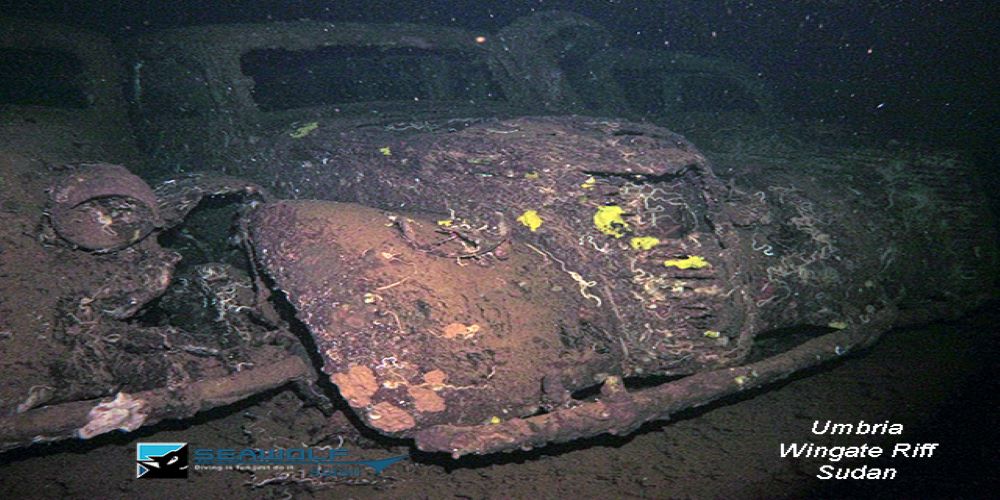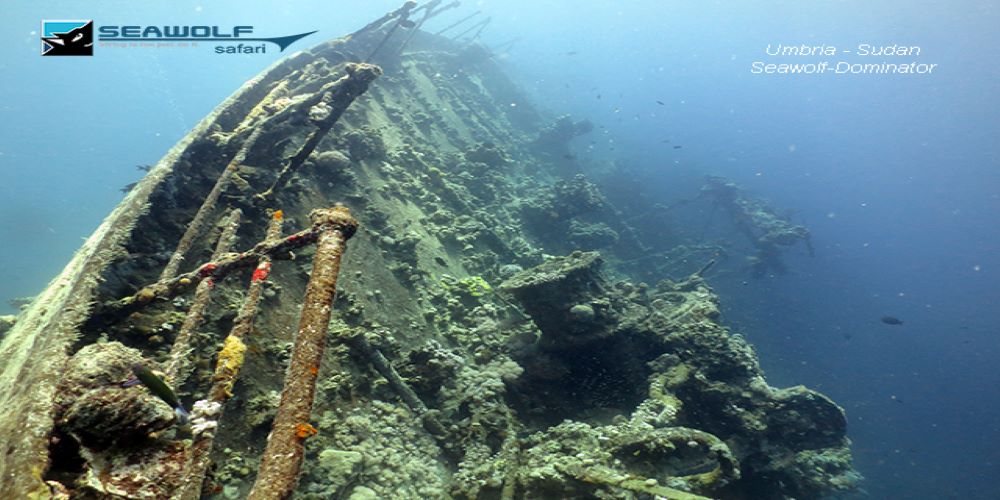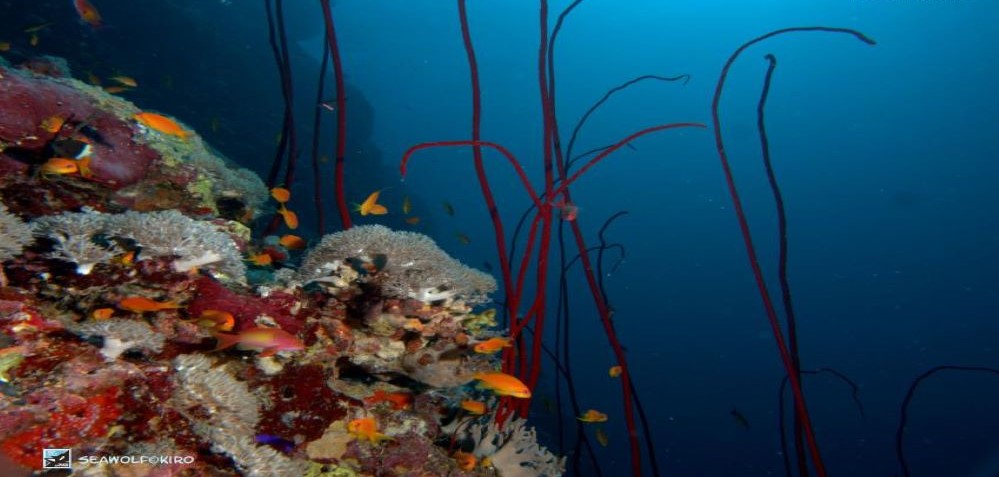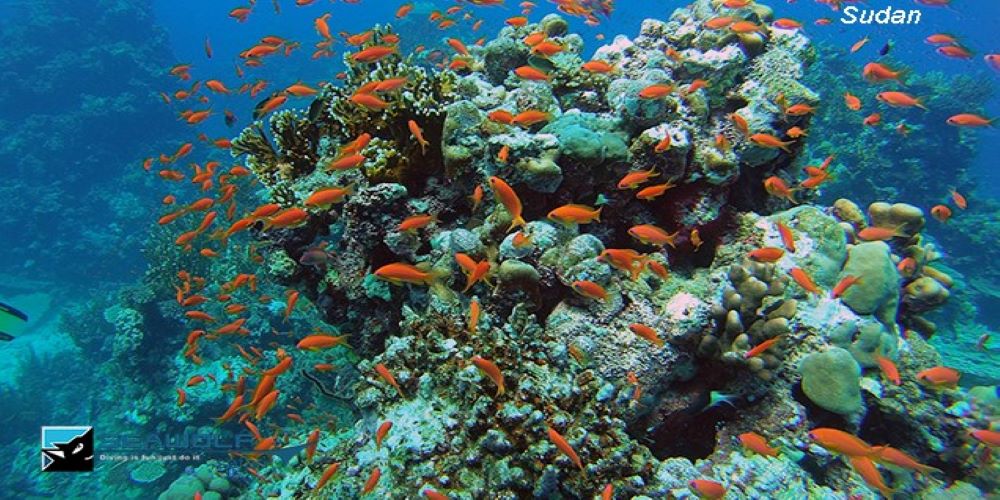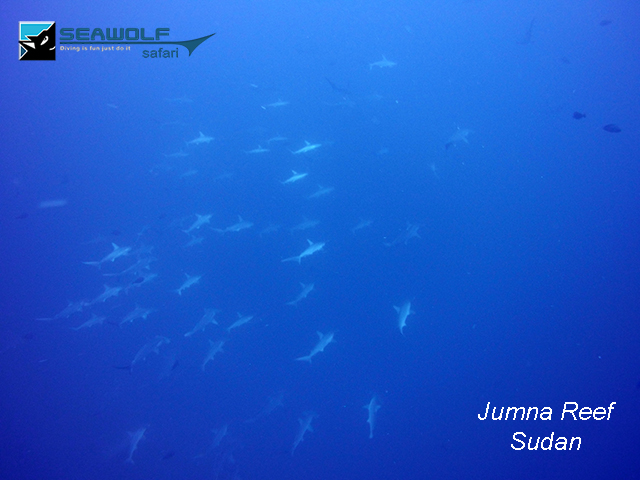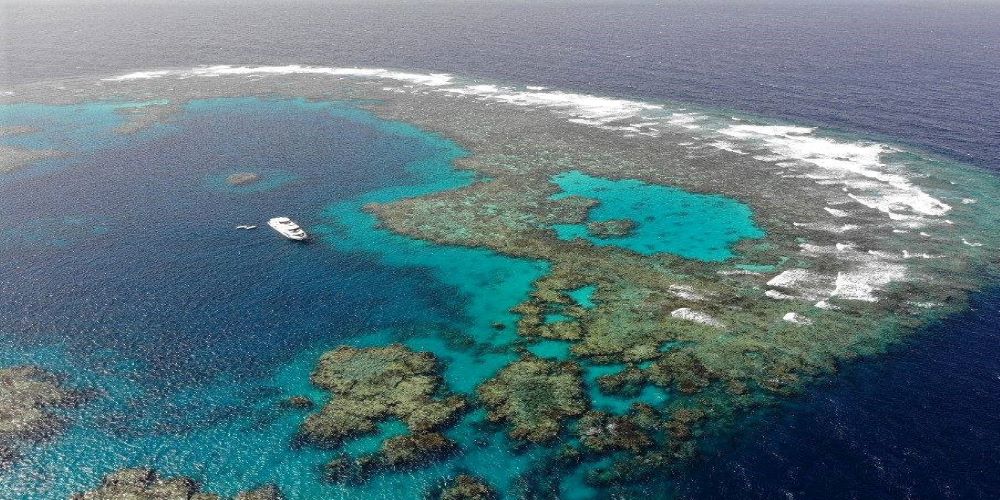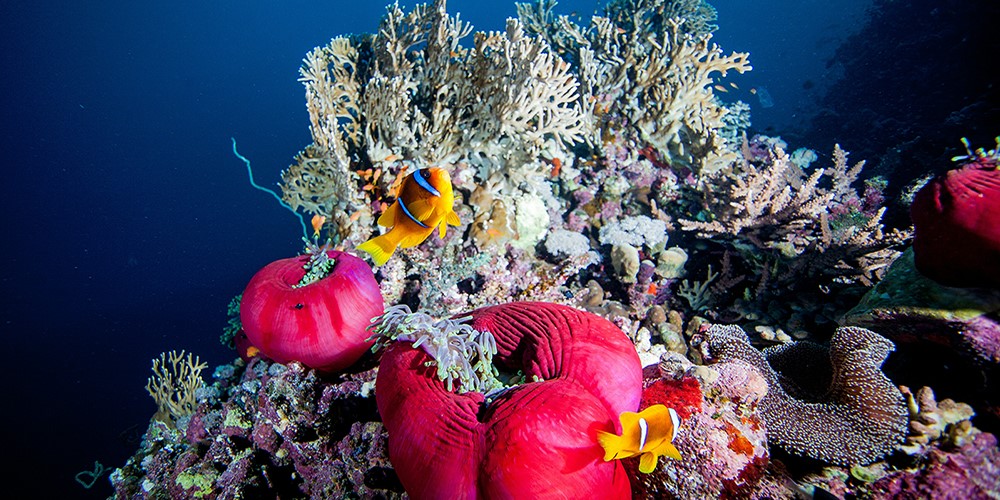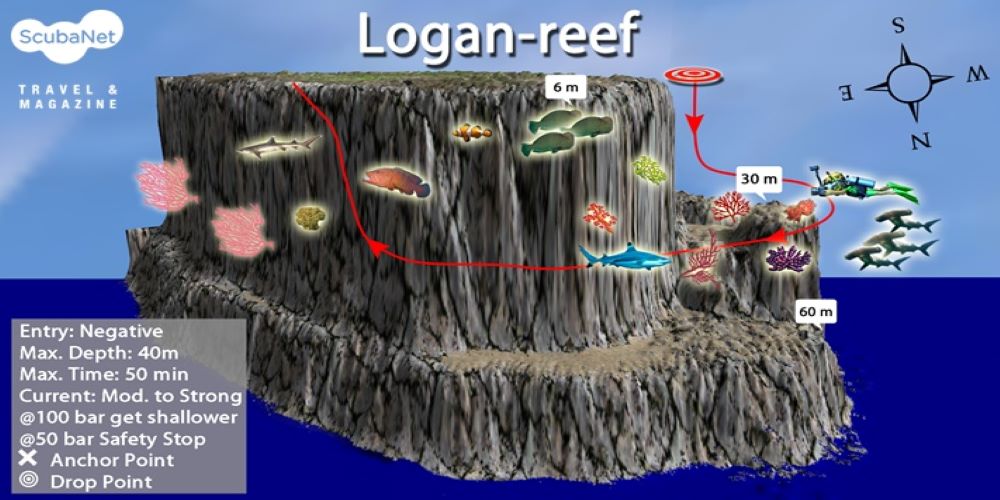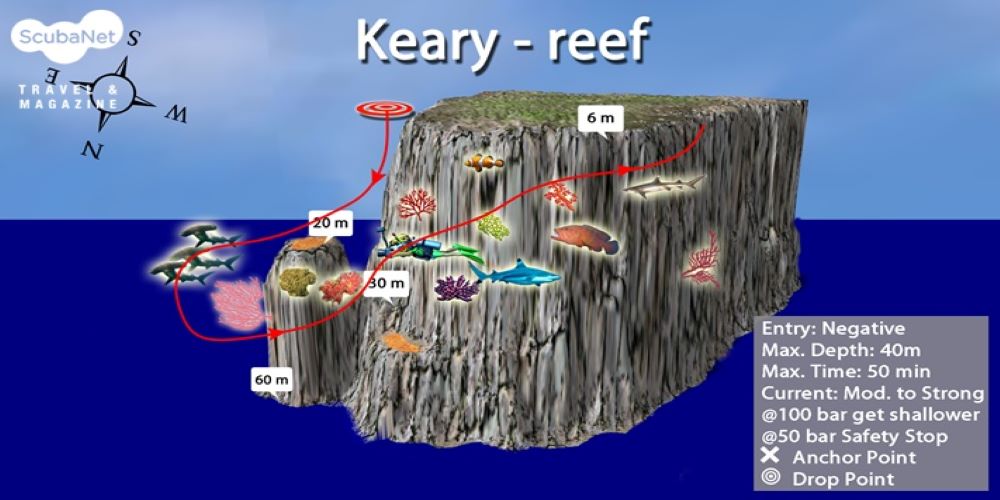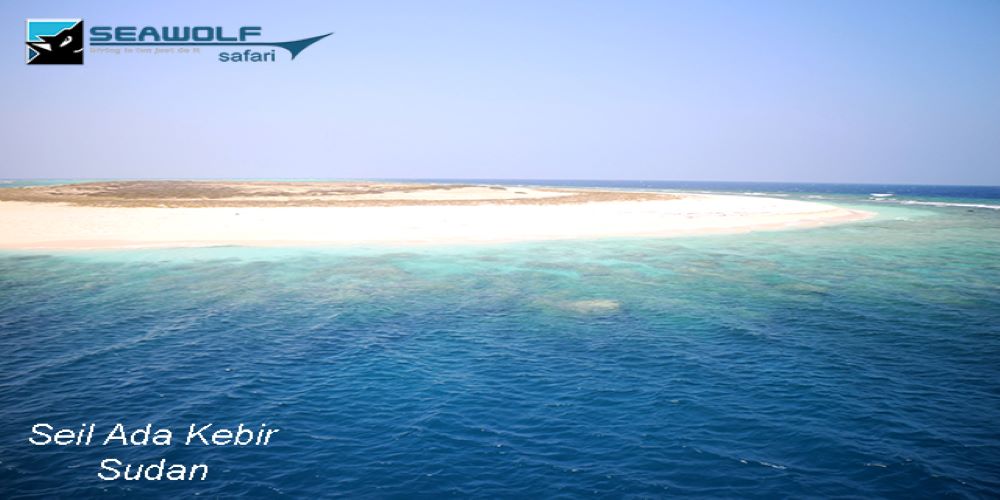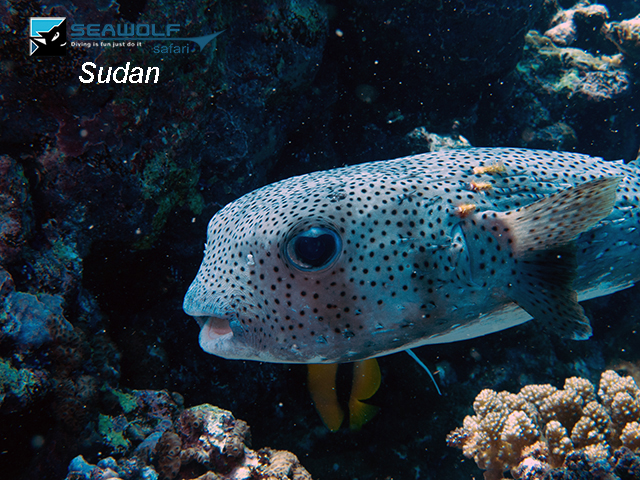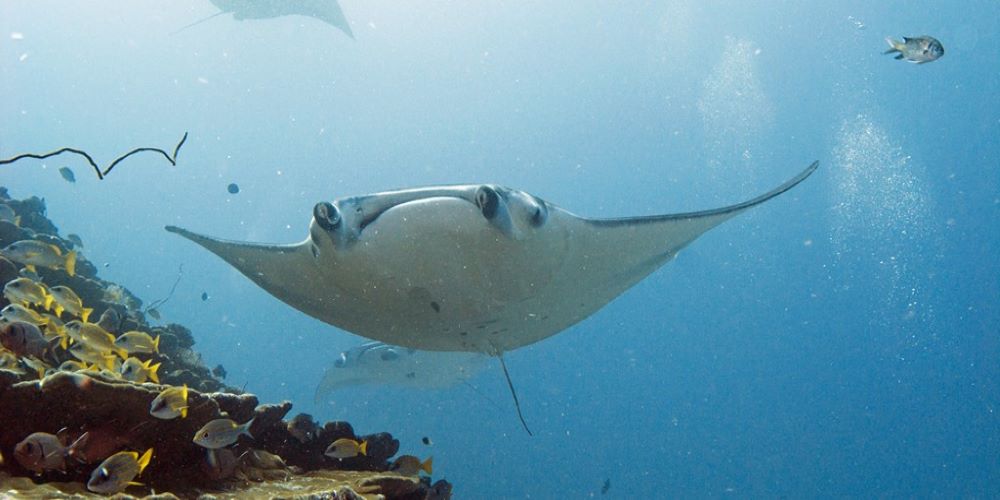Sudan Best of
- The name says it all. This tour shows Sudan from its best side. From Sha'ab Rumi, the reef of Jaques Cousteau over the Wingate Reef, where the Umbria is located, to the south to Sha'ab Ambar you will find a breathtaking, untouched underwater world.
Shaab Rumi
The east side
With the intermittent current, nice drift dives can be made on this side. The reef wall drops steeply into the deep blue. At the southern end of the east side the diver will find a narrow slope from 20 meters. At 30 and 60 meters respectively, small step-like ledges nestle into the slope. The entire wall is beautifully vegetated and huge gorgonians stretch their fans into the current. Vermillion seabass and butterflyfish stand close to the reef. Schools of copper snapper and spiny mackerel move along the wall. Especially in the morning hours pelagic big fishes come up from the depth. On a dive, in addition to various species of sharks, manta rays can occasionally be encountered. At the south end, in the area of the plateau approach, a small collection of anemones can be admired in the shallows. Due to the attractive south plateau, dives on the east side are rarely made.
The north plateau
The frequent northerly current provides a nice growth of stony and soft corals on the three-stepped plateau. The first ledge is in shallow water at 3 to 4 meters water depth. Numerous surgeonfish and various butterflyfish populate the poorly vegetated reef top. Down to a depth of 12 meters there is a sloping slope, which is populated with colonies of white and blue staghorn corals. At the foot of this slope is the second plateau. It descends steadily to 30 meters and is covered with numerous soft corals. The abundance of fish on the plateau is not as great as on the steep wall, where numerous fish and other reef inhabitants fill the corals with bustling life. Below a slope, at a depth of about 60 meters, begins the third stage, on the northern end of which stands a larger coral pile. In the channel between the pile and the slope sometimes silhouettes of hammerhead sharks can be seen. Especially in the period from late summer to autumn, they often move beyond the limits accessible to the recreational diver. On the east side, in the shallower area, schooling fish such as spiny mackerel, copper snapper and red sea fusiliers swim along the reef.
Shaab Rumi South Plateau with Precontinent II
There is a diversity of colors and species that make this dive an unforgettable experience. The reef wall is craggy on the upper 15 to 20 meters and forms numerous caves and crevices. Below this is the tongue-shaped plateau, which descends to 30 meters. Parallel to its base is a small channel. The outer side, covered with numerous hard corals, slopes steeply into the depths.
The southwest tip forms an attraction of this site: A school of scalloped hammerhead sharks frequently patrols the open water. If you dive out into the blue a bit, with a little luck you can observe these reserved sea creatures.However, care should be taken not to swim frantically towards them, otherwise the shy hunters will quickly return to the depths. But be careful: the current can pull you very quickly into the open water without giving you the chance to reach the reef again under your own power.
After a trip to the southern tip, the plateau can then be explored in all its glory. In the center is a mushroom-like, beautifully overgrown coral block. The bottom is covered with gorgonians, leather corals and stony corals, where scorpionfish are lurking for prey swimming by.
At the eastern plateau approach lies an old shark cage, which belongs to the Precontinent II project. Next to it is a plaque commemorating an Austrian diver who died in an accident in 1993.A very trusting school of sweetlips makes this spot a dream for every underwater photographer. With a trained eye and a bit of luck you can also spot a stonefish, which is well camouflaged and lurking for prey.In the shallow area you may encounter grey reef sharks, which move together with white tip reef sharks over the plateau. Sometimes dolphins also pay a visit to the reef.
Sanganeb South/West/North
The south side with the southwest plateau
The most dives are done on the southwest plateau.
The south side forms a vertical reef wall down to a depth of 10 meters and changes into a sloping hillside below. The upper area is craggy and forms numerous small caves and crevices. Above forests of leather coral, one encounters porcupinefish.
The southwest plateau follows to the west. On its base, at a depth of 10 to 15 meters, there are large table corals. Numerous whip corals rise from the bottom, some of them forming entire forests. With such an abundance of species, it is difficult to decide in which direction to continue the dive. On the one hand the pulsating life on the plateau attracts, on the other hand in the area of the edge, as also at the whole outer wall of the reef, grey reef sharks, black tip and hammerhead sharks can be encountered. With a little luck, sea turtles or passing manta rays can be spotted.
The outer edge of the plateau starts at its base at 10 meters and drops to about 33 meters at the extreme southwest tip. At this point, the very craggy outer wall runs almost vertically and forms overhangs. A number of small coral columns, some of which are beautifully covered with purple soft corals, invite you to observe and photograph them. A large swarm of barracudas, which is loyal to its location, makes its circles. It is so trusting that a careful diver can swim up to arm's length to individual animals. A huge school of spiny mackerel is also common. Vermillion seabass occur in this coral garden in limitless numbers. A variety of sponges, leather corals, gorgonians and fire corals settle on the bottom. At the foot of the upper reef wall, a sandy strip runs along the plateau, where large green giant triggerfish have dug their nests into the sand. Caution is advised there as they aggressively defend their nests. The reef wall above the plateau base is so crevassed up to 10 meters that canyons have formed. They are easy to dive.
North plateau
Directly adjacent to the northern tip is an elongated plateau.
The approach to the plateau starts at a depth of 4 meters. Due to the swell and the often stronger currents, it is rarely suitable for diving. However, from its outer edge you can beautifully observe the many small reef fish swimming around in the play of the waves.
Below the first step there is a beautiful slope covered with soft and hard corals. It flows into a channel at a depth of 25 meters. The often strong current makes it impossible to swim against it.
To the north, the plateau rises again to 20 meters and then becomes a steep drop-off. Along the outer side shoals of spiny mackerels, fusiliers and copper snappers pass by. Below them soft corals sway in the current.
The slope offers a magnificent sight. It is covered with numerous soft corals and fan corals that stretch their bodies into the open water.
In the shallower area you may encounter a shoal of barracuda or large groups of double spotted snappers....
Wingate Reef with Umbria
Despite the dangerous situation in the harbor entrance of Port Sudan, the "Umbria" is not salvaged. A no-go zone is declared around the wreck with some of its davits still sticking out of the water and it is then left to its own devices.
Nine years after her sinking, the "Umbria" arouses the interest of Hans Hass, then 30 years old. His contacts with the governor of Port Sudan finally enable him to dive on the "Umbria".
His photo and film material contributed considerably to the myth of the wreck. In the meantime, the "Umbria" is one of the most famous wrecks in the Red Sea.
Located within sight of Port Sudan, it usually marks the beginning or end of a diving safari. Even though the collecting madness of many a diver has left its mark here, the old lady with the explosive cargo has lost none of her charm. The sinking site can be easily identified by the four davits sticking out of the water on the starboard side. The sediment-rich bottom, the immediate location to the harbor entrance, and the low currents often contribute to reduced visibility.
The wreck lies at an angle of 75° to the port side. The three forward holds adjoin the intact bow. Amidships are the crew quarters and the bridge. Towards the stern, two more holds and the aft deck follow. Both the cargo holds and the midship superstructure can be comfortably explored.
However, due to the extreme inclination and the dangerous cargo, extreme caution is advised when touching objects. If you approach the bow of the "Umbria" from the open water, the steeply rising bow with the flagpole stands out mystically in the greenish water.
The two anchor chains run to the bottom, as the "Umbria" was at anchor when she sank. The anchor winch and the railing are covered with coral.
Some of the deck planking is still in surprisingly good condition. The small cargo hatches are an indication of the ship's age. The first hold, accessed from the foredeck, contains the omnipresent munitions, wooden crates, electrical equipment and aircraft tires. The second, somewhat larger hold contains bombs, grenades, and stick grenades. The detonators, which are stored separately from the explosives, are scattered in almost every hold. The third hold is one of the most visited.
Besides cement bags and other building materials, wine bottles and jam jars are found here.
Through a narrow passage on the port or starboard side, the first cargo level leads to the midship area, where three vehicles are parked.
The Fiat 1100 Lunga were specially designed for off-road use in the Italian colonies. Unfortunately, several divers have already left their marks on the vehicles. The fine sediment makes visibility drop to zero after only a short time, so if possible this part of the ship should be visited with small groups at longer intervals. The midship section with the bridge and its superstructures can easily be explored by snorkeling. On the starboard side 4 empty davits protrude from the water. On this side is also a single bathroom with toilet, bathtub and an enamel sink.
The massive engine room is accessed either through one of the open skylights behind the funnel or through the workshop accessible from aft. The multi-level room is easy to dive in the upper sections, while the lower ones are reserved for experienced divers.
Grates border the numerous aggregates. On the seabed toward the port side of the superstructure are wind scoops, cargo booms, the broken chimney, and a lifeboat. Towards the stern, two more cargo holds are connected. They are partly covered by the fallen derricks. As in the front holds, munitions, construction material and various war equipment can be found here. The single-story superstructure between the fourth and fifth holds houses the galley and some stores. The stern is now without planking. The red soft coral on the railing as well as the deck strutting provides the necessary color. The steering gear and the exposed steering chain are clearly visible. Below the railing, the huge rudder blade and the starboard propeller are impressive. The port propeller has sunk into the floor. Beneath the rudder blade is a huge artificial cavern that can only be exited through two exits. The twilight contributes to a mystical atmosphere..
Umbria
Over 360,000 bombs and 60 boxes of fire bombs and other explosives are stowed in the 5 holds. Furthermore cars, airplane parts as well as cement bags and other building materials.
The Umbria's route takes it via Messina in Sicily to Port Said, from where it is to sail through the Suez Canal and the Red Sea to East Africa.
After entering Port Said on June 3, she bunkers another 1000 tons of coal and 130 tons of water. Here 23 British Navy soldiers as well as 2 pilots board the ship. In view of the imminent entry into the war between Italy and England, the Channel passage is deliberately delayed. So the "Umbria" leaves Suez with her explosive cargo only 3 days later.
From now on, the gunboat "Grimsby" pursues her. It stops the freighter at Port Sudan, claiming that she is in British territorial waters. As a result, the "Umbria" drops anchor at Wingate Reef on June 9.
Under the pretext of searching the ship for smuggled goods, 22 soldiers from the New Zealand cruiser "Leander" are brought on board under the command of Lieutenant Steves. They immediately occupy the strategically important points and begin a time-consuming search.
In the afternoon, Captain Muiesan learns over the radio in his cabin that Italy will declare a state of war at 7:00 p.m. and that the first acts of war are to be expected from 0:00 a.m. the following day.
Muiesan realizes that he cannot lose any more time, so that the strategically important cargo does not fall into enemy hands. Together with first officer Radolfo Zarli and flight engineer Carlo Costa, he plans the sinking.
They have difficulty evacuating the crew without attracting attention.
Finally, Muiesan suggests to Lieutenant Steves to carry out a rescue exercise, which the Lieutenant approves in the hope of being able to detain the "Umbria" even further. While the Italians begin the exercise, news reaches Steves on the bridge of severe water ingress throughout the ship. After a few minutes and with the increasing list of the ship, he realizes that he can no longer prevent the sinking.
On board the "Gimsby", Muiesan informs him of Italy's entry into the war and that he had given the order to sink the ship himself.
He then goes with his crew to India as prisoners of war before the outbreak of war.
Hindi Gider
It can be recognized from far away by its unmanned lighthouse. It consists of a 27 meter high steel construction. Its cone of light is visible at night for up to 10 nautical miles. Its purpose is to warn ships on their way to and from Port Sudan of the many shallows in this region.
North side
The reef wall drops steeply and in small gradations into the deep blue.
The drop-off is beautifully covered with stony and soft corals. Huge fan gorgonians stand in the current to filter plankton from the water. Small feather stars have made a home for themselves on them.
In the shallower area there is an extremely rich underwater fauna. Shoals of vermillion seabass and butterflyfishes are standing on the wall. In many small crevices you can discover cleaning stations with their numerous visitors. Encounters with whitetip reef sharks, blacktip reef sharks and hammerheads are not uncommon.
The east side
The reef wall is very rugged, especially on the first meters, forming many small caves and crevices. Numerous black spot snappers and various butterfly fish swim around between the corals.
South of the lighthouse a soft coral garden has developed. It is unique in its colors and shapes. Different species of the Red soft tree coral grow close to each other and sometimes hang down from overhangs in bizarre shapes. Underwater photographers will find countless interesting subjects. The entire wall is covered with a magnificent carpet of soft and leather corals.
Protector Reef
North plateau
The reef wall drops vertically to 15 meters. It is covered with crevices and small caves, which are home to numerous reef dwellers. It is followed by a shallow plateau where some wreckage of an unknown ship is scattered. The bottom is covered with colorful soft corals. Schools of barracudas are swimming above whip corals. On the outside the plateau drops steeply into the deep blue. Remarkably large fan gorgonians grow on the wall and offer underwater photographers attractive motives. Often one encounters whitetip and grey reef sharks.
South Plateau
The south plateau is characterized by its step-like structure. The first step is at 3 to 5 meters. Countless small reef dwellers populate the shallow water area which is flooded with light. They include yellow-brown boxfish, surgeonfish and several species of goby. In 13 and 20 meters there are more steps. These are covered with numerous small coral blocks. Stony corals, with whip corals rising between them, dominate the bottom. Shoals of spiny mackerels swim above them. Occasionally white tip reef sharks can be encountered, too. At the approximately 300 meter long plateau, as well as on the north side, stronger currents must be expected.
Jumna Reef
This coral tower drops steeply into the depths. The largest known school of scalloped hammerhead sharks in the Sudan Sea gathers here. Grey reef sharks and silver tip sharks are also often seen here.
On the eastern side, at a depth of 30 meters, there is a large cave where whitetip sharks often rest.
During the ascent of the wall you will see a large number of holes, which especially offer photographers a spectacular view of this habitat.
Shaab Ambar
It is a massive reef system that stretches for 5 km, with a lagoon in the middle that is ideal for night dives and overnight stays.
At the southeastern end is a very nice plateau, where on the sandy flats, in moderate currents, surgeonfish, hunting barracuda, large tuna, sand eels and small whitetip reef sharks can be found.
At the drop off, if the current allows it, you can see schools of hammerheads and gray reef sharks.
Pinnacle
The reef is colored with pink, yellow and red soft corals. The whole coral block is full of marine life wherever you look. During the safety stop you can admire a few anemone stocks in the 5 - 6 m area.
Golden banded fuseliers attract predators such as tuna and due to the usually strong current, this site is a meeting point for hammerhead sharks, whitetip reef sharks and gray sharks.
Logan Reef
During a detour into the blue water you can meet single specimens or even schools of hammerheads and gray reef sharks. After returning to the plateau, we continue the dive with the reef on the right side.
We are now on the eastern ridge of the reef, where we swim through clouds of fish that are absolutely unconcerned about our presence. On the bottom at a depth of 45 meters is a series of small plateaus richly covered with soft corals and gorgonians. Also here you can find different species of reef fish and schools of large bumphead parrotfish nibbling on corals. The reef wall drops steeply into the blue.
Keary Reef
Diving on the northern side of the reef, one directly encounters an infinite number of whip corals and fan gorgonians. At 20 meters you will find a series of coral blocks that reach a depth of 60 meters. The reef has beautifully vegetated drop-offs and even in the blue water it can offer pelagic .
Seil Ada Kebir
At the northern tip, the reef drops to a plateau in 20 - 25 meters - it is overflowing with fish that live here permanently.
The area is also inhabited by various species of reef sharks.
On this island the powder-white sand creates a perfect ground for different kinds of turtles. At the right time of the year you can watch the turtles slowly crawling out of the sea to lay their eggs. Turtles are almost always guaranteed at this dive site.
Towartit Reef
Towartit Reef is 18 nautical miles long in the north-south direction and has a width of 9 nautical miles in the west-east direction. There are no accurate nautical charts of the area and part of the reef group has not yet been charted. This is another reason why it has become a graveyard for numerous ships. Wreck lovers will get their money's worth here.
On several reefs in the north there are sea marks to warn ships of shallows on their way to Port Sudan. One dive site is located just south of the northernmost seamark.
Shielded by a long reef to the east and two small reefs to the west and south, it is possible to anchor there.
On the inside the seabed drops to a depth of 9 to 22 meters. On the outside near the northern tip, the bottom drops steeply to 80 meters.
Barra Musa Kebir
Barra Musa Kebir is covered with green bushes in the middle. Sea turtles use the beach to lay their eggs. On the south side there is an extremely attractive plateau. On the west and east side there are drop-offs that will delight any wall diver.
North side
The reef wall is rugged and drops off vertically for the first 10 to 15 meters. Lionfish wait in the reef crevices or under ledges for the night to catch prey. Small longnose hawkfish hide in the branches of fan gorgonians. Below the wall begins a two-step slope covered with coral heads. One notices the numerous soft corals that populate the slope. As on the other sides, various species of sharks can be encountered.
South plateau
From the water surface to the base of the plateau, the reef wall drops almost vertically. It forms numerous crevices and small caves populated by various marine life. The plateau slopes gently downward from a depth of 23 meters. It is covered with small coral heads covered with soft corals. From diadem sea urchins and Feather stars to surgeon fish and giant moray eels, many interesting things can be observed in a very small space. With a bit of luck, you may spot a stonefish lying in ambush. At the edge, at a depth of 26 meters, the visitor reaches an almost vertical drop-off, which has large caves in places. Especially at the southern tip, large fish are encountered.
Itinerary
ATTENTION: The tour description is only a suggestion. Which dive sites are dived on the tour depends on many factors, including wind and weather.
Arrival
After arrival in Port Sudan transfer to the boat.
Check in, dinner and spending the first night on board in the marina.
Departure
Departure in the morning.
Familiarization of the boat,
Diving, safety and equipment briefing.
Dive at Wingate Reef and Precontinent II
Night dive at Shaab Rumi Lagune
Shaab Rumi
Two dives at Shaab Rumi south
Sanganeb west
Nicht dive at Sanganeb west
Jumna Reef
Two dives at Jumna Reef
One dive at Shaab Amber
Night dive at Shaab Amber
Logan Reef
Dive at
Logan Reef
Shaab Amber south plateau
Sanganeb south plateau
Night dive at Sanganeb Lagoon
Sanganeb
Two dives at
Sanganeb south plateau
Sanganeb Lighthouse
Night dive at SS Umbria
Return
Two dives at SS Umbria
Return to the port.
For safety reasons you should not dive 24 hours before your flight home.
Check out
Breakfast and departure.
Transfer to the airport.

 ENGLISH
ENGLISH
 РУССКИЙ
РУССКИЙ
 DEUTSCH
DEUTSCH

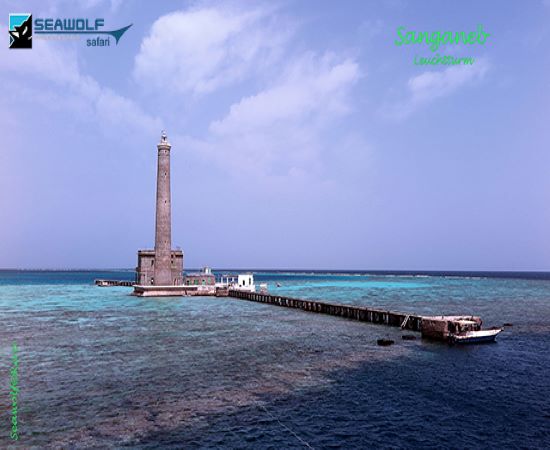
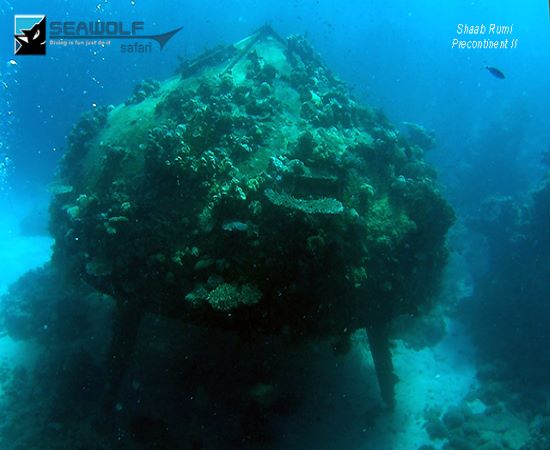
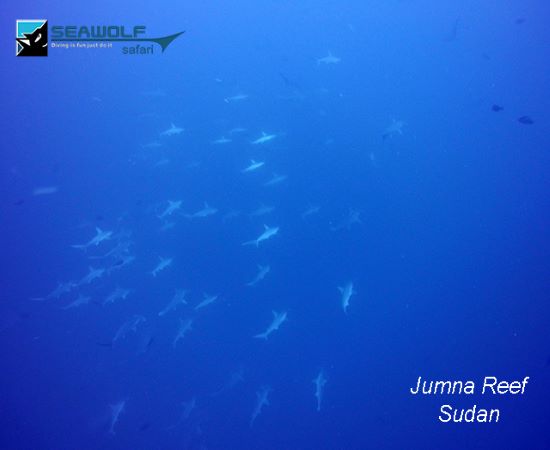
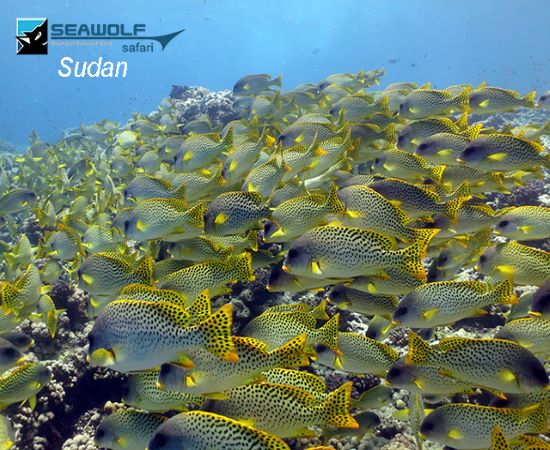
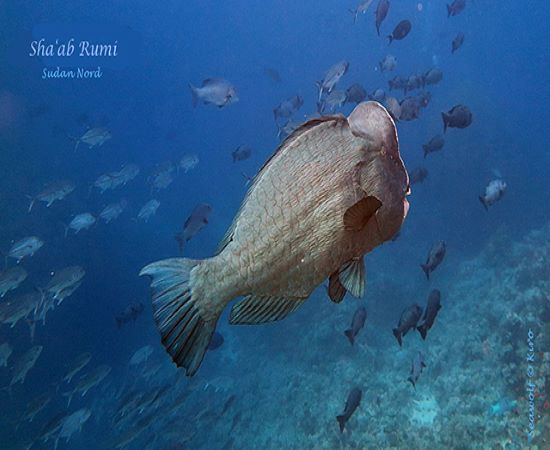
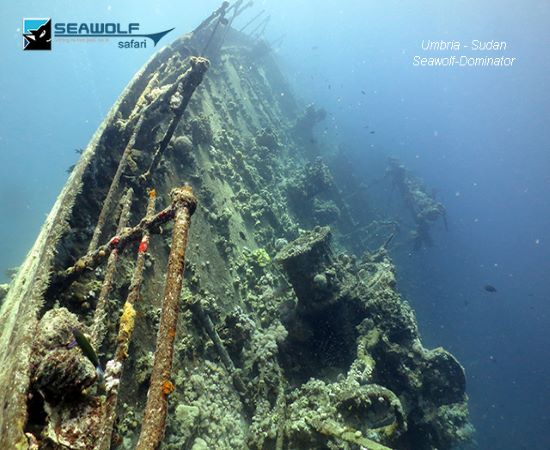
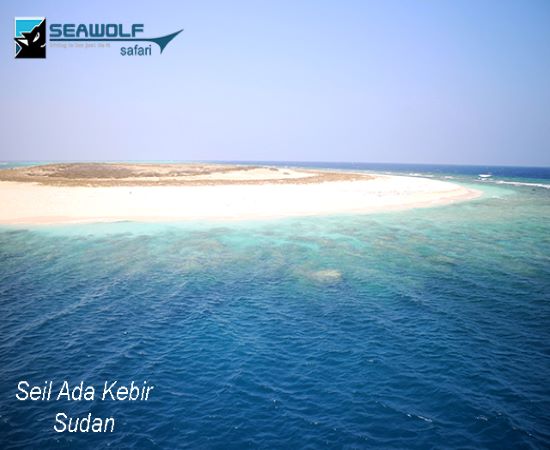
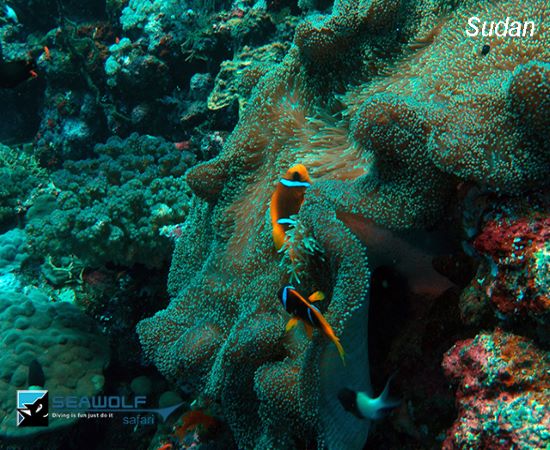
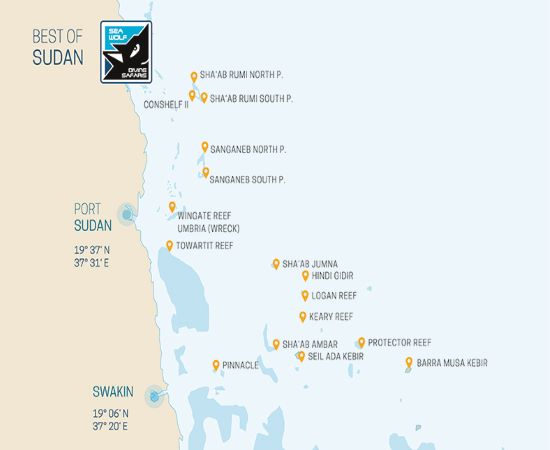
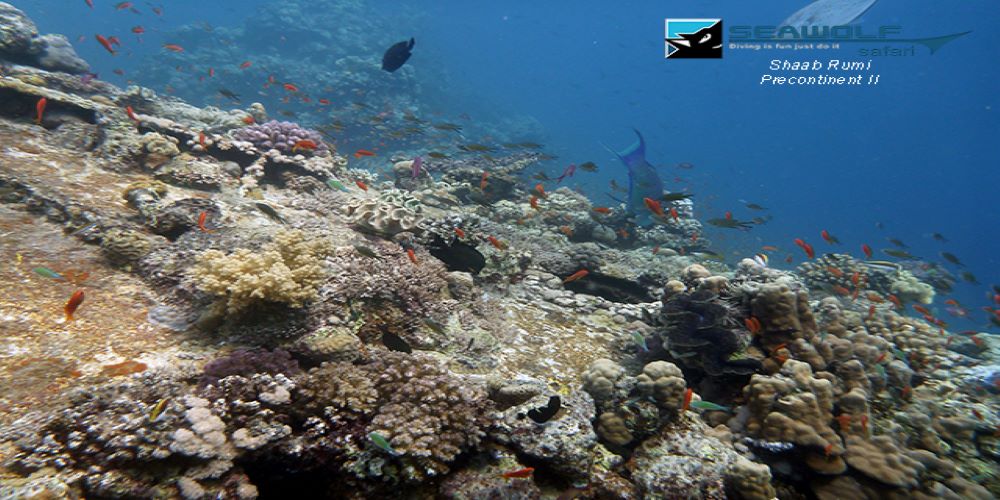
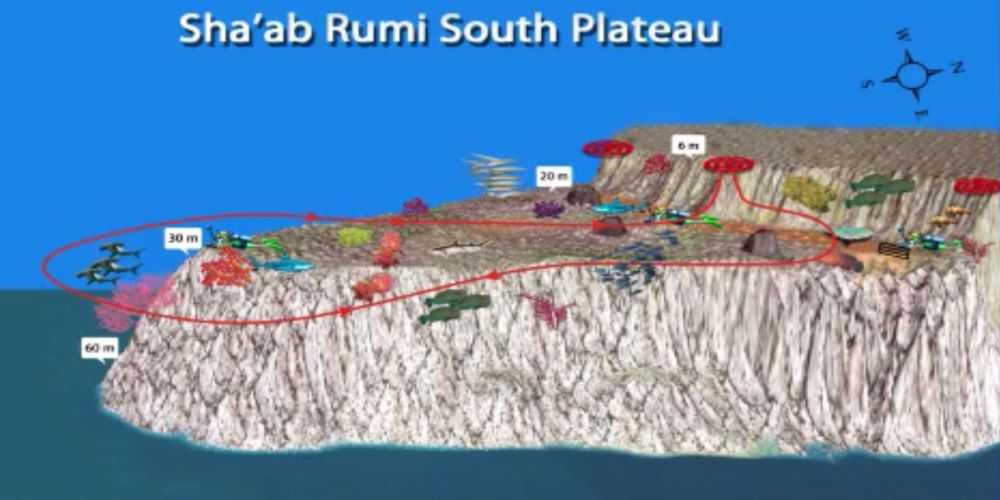
new_lg.jpg)
